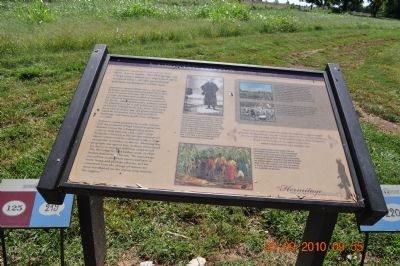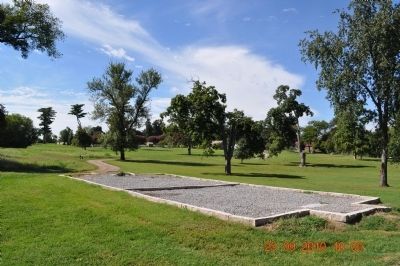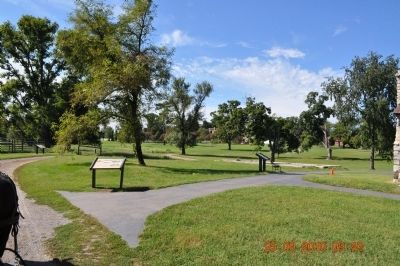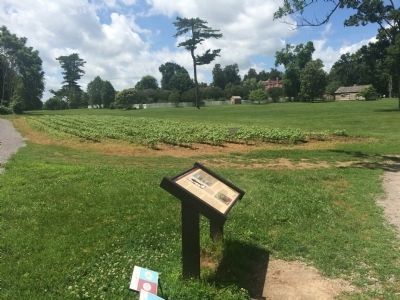Hermitage in Davidson County, Tennessee — The American South (East South Central)
Growing Cotton
A Risky Venture
Jackson’s cotton proved to be a risky venture with the potential of high reward or great loss. Because cotton has a long growing season, a late or early frost can ruin a year’s crop. Nashville’s location as the northernmost point where cotton could be cultivated made it more susceptible to weather variations. Realizing that geography was against him, Jackson often stated his desire to switch to different crops or sell The Hermitage for land further south. In 1836, Andrew Jackson wrote to his son, “We must change our culture in part from cotton and turn to stock, hemp and perhaps tobacco, as I am convinced from the change of seasons we must not depend on the cotton crop entirely for support.”
Topics and series. This historical marker is listed in these topic lists: African Americans • Agriculture. In addition, it is included in the Former U.S. Presidents: #07 Andrew Jackson series list.
Location. 36° 12.995′ N, 86° 36.673′ W. Marker is in Hermitage, Tennessee, in Davidson County. Marker can be reached from Rachel's Lane. Located at The Hermitage historical site. Touch for map. Marker is in this post office area: Hermitage TN 37076, United States of America. Touch for directions.
Other nearby markers. At least 8 other markers are within walking distance of this marker. Land Conservation at The Hermitage (within shouting distance of this marker); A home for Jackson’s Slaves (within shouting distance of this marker); The Hermitage Landscape (within shouting distance of this marker); A Future President's Home (within shouting distance of this marker); Abandonment and Preservation (within shouting distance of this marker); The First Hermitage (within shouting distance of this marker); The Belted Galloway (within shouting distance of this marker); Field Quarter Trail (within shouting distance of this marker). Touch for a list and map of all markers in Hermitage.
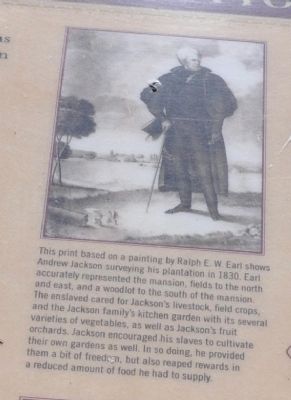
Photographed By Sandra Hughes, September 25, 2010
4. Andrew Jackson
This print based on a painting by Ralph E. Earl shows Andrew Jackson surveying his plantation in 1830 Earl accurately represented the mansion, fields to the north and east, and woodlot to the south of the mansion. The enslaved cared for Jackson’s livestock, field crops, and the Jackson family kitchen garden with its several varieties of vegetables, as well as Jackson’s fruit orchards. Jackson encouraged his slaves to cultivate their own gardens as well. In doing, he provided them a bit of freedom, but also reaped rewards in a reduced amount of food he had to supply.
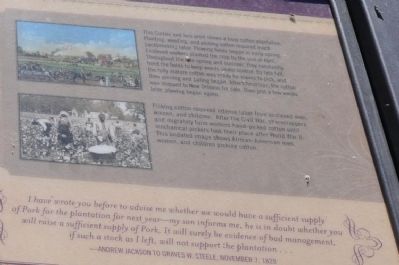
Photographed By Sandra Hughes, September 25, 2010
5. Growing Cotton
This Currier and Ives print shows a busy cotton plantation, planting, weeding, and picking cotton required much backbreaking labor. Plowing fields began in early spring. Enslaved workers planted the crop by the end of April. Throughout the spring and summer, they constantly hoed the fields to keep weeds under control. By late fall, the fully mature cotton was ready for slaves to pick, and then ginning and baling began. After Christmas, the cotton was shipped to New Orleans for sale. Then just a few weeks later, plowing began again.
Picking cotton required intense labor from enslaved men, women and children. After the Civil War, sharecroppers and migratory farm workers handpicked cotton until mechanical pickers took their place after World War II. This undated image shows African –American men, women, and children picking cotton.
I have wrote you before to advise me whether we would have a sufficient supply of Pork for the plantation for next year- my son informs me, he is in doubt whether you will raise a sufficient supply of Pork. It will surely be evidence of bad management if such a stock as I left, will not support the plantation…
- Andrew Jackson to Graves W. Steele, November 7, 1829
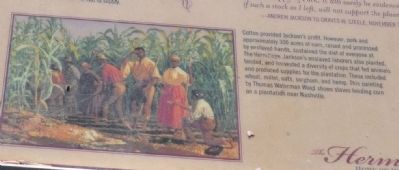
Photographed By Sandra Hughes, September 25, 2010
6. Growing Cotton
Cotton provided Jackson’s profit. However, pork and approximately 300 acres of corn, raised and processed by enslaved hands, sustained the died of everyone at the Hermitage. Jackson’s enslaved laborers also planted, tended, and harvested a diversity of crops that fed animals and produced supplies for the plantation. These included wheat, millet, oats, sorghum, and hemp. This painting by Thomas Waterman Wood shows slaves tending corn on a plantation near Nashville.
Credits. This page was last revised on February 7, 2023. It was originally submitted on February 10, 2012, by Sandra Hughes Tidwell of Killen, Alabama, USA. This page has been viewed 612 times since then and 4 times this year. Last updated on March 13, 2015, by J. Makali Bruton of Accra, Ghana. Photos: 1, 2, 3, 4, 5, 6. submitted on February 10, 2012, by Sandra Hughes Tidwell of Killen, Alabama, USA. 7. submitted on July 12, 2015, by J. Makali Bruton of Accra, Ghana. • Bill Pfingsten was the editor who published this page.
